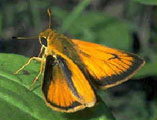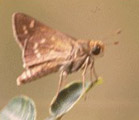Native Plants
Search for native plants by scientific name, common name or family. If you are not sure what you are looking for, try the Combination Search or our Recommended Species lists.
Panicum virgatum
Panicum virgatum L.
Switchgrass, Wand Panic Grass
Poaceae (Grass Family)
Synonym(s):
USDA Symbol: PAVI2
USDA Native Status: L48 (N), HI (I), CAN (N)
Clump-forming, warm-season grass with open, lacy sprays with small seeds, Aug-Oct. Purple stigmas at flowering time. Switchgrass is a 3-10 ft., rhizomatous, loose sod former with a large, open, finely textured, reddish-purple seedhead. Fall color is pale yellow. Bright green leaves occur up and down the stem, turning bright yellow in fall. Switchgrass is a perennial. Grows in large clumps, with many persistent, curly leaves.
Switchgrass is one of the dominant species of the tallgrass prairie, but also grows along roadsides where moisture is present. The rich, yellow-colored clumps last throughout the winter.
Plant Characteristics
Duration: PerennialHabit: Grass/Grass-like
Root Type: Fibrous
Leaf Arrangement: Alternate
Leaf Complexity: Simple
Leaf Shape: Linear
Leaf Venation: Parallel
Leaf Margin: Entire
Inflorescence: Panicle
Fruit Type: Caryopsis
Size Notes: Up to about 10 feet tall, often shorter.
Leaf: Green
Bloom Information
Bloom Color: Green , BrownBloom Time: Aug , Sep , Oct , Nov
Bloom Notes: Pollinated by wind.
Distribution
USA: AL , AR , AZ , CO , CT , DC , DE , FL , GA , HI , IA , ID , IL , IN , KS , KY , LA , MA , MD , ME , MI , MN , MO , MS , MT , NC , ND , NE , NH , NJ , NM , NV , NY , OH , OK , PA , RI , SC , SD , TN , TX , UT , VA , VT , WI , WV , WYCanada: MB , NS , ON , QC , SK
Native Distribution: Que. to Sask. & MT, s. through FL to Cuba, & through all but the westernmost US, continuing through much of Mexico to Central America. Most common in the central plains of North America.
Native Habitat: Dry or moist prairies; bluffs; stream banks; open woods. In moist and seasonally damp open places throughout Texas, except for Trans-Pecos. Sand, loam, clay, limestone; poor drainage okay.
Growing Conditions
Water Use: MediumLight Requirement: Sun , Part Shade
Soil Moisture: Dry , Moist
CaCO3 Tolerance: Low
Soil Description: Dry to moist soils. Sandy, Sandy Loam, Medium Loam Clay Loam, Clay, Limestone-based.
Conditions Comments: Clump-forming, warm-season grass with open, lacy sprays with small seeds. Switchgrass is a loose sod former with a large, open, finely textured, reddish-purple seedhead. Bright green leaves occur up and down the stem, turning bright yellow in fall.
Benefit
Use Ornamental: Attractive, Fall conspicuous, Pocket prairie, Grows in clumps, AccentUse Wildlife: Fair Grazing; Seeds eaten by ground-feeding songbirds and game birds; Provides cover and nesting material.
Use Other: Used for range re-seeding.
Conspicuous Flowers: yes
Interesting Foliage: yes
Attracts: Birds , Butterflies
Larval Host: Delaware Skipper. The Grass Family is an essential larval host for most banded skippers and most of the satyrs.
Deer Resistant: High
Butterflies and Moths of North America (BAMONA)
|
Delaware Skipper (Anatrytone logan)  Adult Food Source Larval Host |
Dotted Skipper (Hesperia attalus)  Larval Host |
Propagation
Description: Propagate by sowing unstratified seed in fall or stratified seed in spring. Sow 1/4"Seed Treatment: Dry stratification.
Commercially Avail: yes
Find Seed or Plants
Order seed of this species from Native American Seed and help support the Wildflower Center.
Find seed sources for this species at the Native Seed Network.
View propagation protocol from Native Plants Network.
Mr. Smarty Plants says
When to plant grasses on Long Island, NY
December 06, 2009
Dear Mr. Smarty Plants;
Are there any grass seeds that I can plant NOW, early December, on Long Island, NY? The planting environment is on and near a sandy bluff on a bayshore, where it can be windy ...
view the full question and answer
Plants to control hillside erosion in Vermont
May 23, 2008
Hi, I am trying to do an eagle project that involves putting vegetation onto a hill to prevent erosion. I live in Vermont. What kinds of plants would hold together a hillside and could be planted in ...
view the full question and answer
Using Native Plants Database to determine flowering time in Austin
April 07, 2006
How can I access your data base to learn what plants are flowering in Austin during the months of October and early November?
view the full question and answer
National Wetland Indicator Status
| Region: | AGCP | AK | AW | CB | EMP | GP | HI | MW | NCNE | WMVE |
| Status: | FAC | FACW | FAC | FAC | FAC | FAC | FACW |
From the National Organizations Directory
According to the species list provided by Affiliate Organizations, this plant is on display at the following locations:Lady Bird Johnson Wildflower Center - Austin, TX
Native Plant Center at Westchester Community College, The - Valhalla, NY
Texas Discovery Gardens - Dallas, TX
Delaware Nature Society - Hockessin, DE
Patsy Glenn Refuge, c/o Wimberley Birding Society - Wimberley, TX
United States Botanic Garden - Washington, DC
NPSOT - Native Plant Society of Texas - Fredericksburg, TX
Crosby Arboretum - Picayune, MS
Nueces River Authority - Uvalde, TX
Texas Parks and Wildlife Department - Austin, TX
NPSOT - Fredericksburg Chapter - Fredericksburg, TX
North American Native Plant Society - Etobicoke, ON
Texas Master Naturalists - Lost Pines Chapter - Bastrop, TX
Native Seed Network - Corvallis, OR
Jacob's Well Natural Area - Wimberley, TX
NPSOT - Williamson County Chapter - Georgetown, TX
Bibliography
Bibref 1186 - Field Guide to Moths of Eastern North America (2005) Covell, C.V., Jr.Bibref 1185 - Field Guide to Western Butterflies (Peterson Field Guides) (1999) Opler, P.A. and A.B. Wright
Bibref 1620 - Gardening with Native Plants of the South (Reprint Edition) (2009) Wasowski, S. with A. Wasowski
Bibref 946 - Gardening with Prairie Plants: How to Create Beautiful Native Landscapes (2002) Wasowski, Sally
Bibref 841 - Native Alternatives to Invasive Plants (2006) Burrell, C. C.
Bibref 318 - Native Texas Plants: Landscaping Region by Region (2002) Wasowski, S. & A. Wasowski
Bibref 291 - Texas Wildscapes: Gardening for Wildlife (1999) Damude, N. & K.C. Bender
Bibref 1294 - The Midwestern Native Garden: Native Alternatives to Nonnative Flowers and Plants An Illustrated Guide (2011) Adelman, Charlotte and Schwartz, Bernard L.
Search More Titles in Bibliography
Web Reference
Webref 38 - Flora of North America (2019) Missouri Botanical Garden, St. Louis, MO & Harvard University Herbaria, Cambridge, MA.Research Literature
Reslit 260 - The Role of Panicum virgatum (Switch Grass) in the Revegetation of Iron-Mine Tailings in Northern New York (1995) Y. D. Choi and M. K. WaliReslit 226 - Latitudinal and longitudinal adaptation of switchgrass populations (2007) M. D. Casler, K. P. Vogel, C. M. Taliaferro, N. J....
Reslit 130 - Performance of grass barriers and filter strips under interrill and concentrated flow (2006) H. Blanco-Canqui, C. J. Gantzer and S. H. Anderson
Reslit 526 - Simulating Switchgrass Growth and Development under Potential and Water-Limiting Conditions (2009) P. Grassini, E. Hunt, R. B. Mitchell and A. Weiss
Reslit 505 - The Mycorrhizal Fungus, Sebacina vermifera, Enhances Seed Germination and Biomass Production in Switchgrass (Panicum virgatum L) (2009) S. R. Ghimire, N. D. Charlton and K. D. Craven
Reslit 401 - Host plant species effects on arbuscular mycorrhizal fungal communities in tallgrass prairie (2000) A. H. Eom, D. C. Hartnett and G. W. T. Wilson
Reslit 387 - Ecophysiology of two native invasive woody species and two dominant warm-season grasses in the semiarid grasslands of the Nebraska Sandhills (2006) K. D. Eggemeyer, T. Awada, D. A. Wedin, F. E. Harv...
Reslit 354 - Spatial variability of switchgrass (Panicum virgatum L.) yield as related to soil parameters in a small field (2007) N. Di Virgilio, A. Monti and G. Venturi
Reslit 322 - Genetic variability and interrelationships of seed yield and yield components in switchgrass (2009) M. K. Das and C. M. Taliaferro
Reslit 549 - Responses of three switchgrass (Panicum virgatum L.) cultivars to seed priming and differential aging conditions (2008) G. Hacisalihoglu
This information was provided by the Florida WIldflower Foundation.
Search More Titles in Research Literature
From the Archive
Wildflower Newsletter 1985 VOL. 2, NO.4 - Message From Helen Hayes, Head for the Hill Country, Spring Tours at the Center,...Wildflower Newsletter 1986 VOL. 3, NO.3 - Fall Planting Tips, Growth Provides Enthusiasm, 1985 Financial Facts, Gathering ...
Wildflower Newsletter 1998 VOL. 15, NO.4 - Grasses from the Ground Up, Celebrating Wildflowers Hotline, Executive Director\...
Additional resources
USDA: Find Panicum virgatum in USDA PlantsFNA: Find Panicum virgatum in the Flora of North America (if available)
Google: Search Google for Panicum virgatum
Metadata
Record Modified: 2023-01-25Research By: TWC Staff, WFS